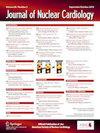Assessment of sestamibi CZT-SPECT reconstructed using deep-learning-based virtual attenuation correction maps according to coronary artery territory and with comparison to rubidium-PET
IF 3
4区 医学
Q2 CARDIAC & CARDIOVASCULAR SYSTEMS
引用次数: 0
Abstract
Background
Attenuation artifacts affect the analysis of single-photon emission computed tomography (SPECT) myocardial perfusion imaging, especially in the right coronary artery (RCA) territory, although computed tomography (CT)-based attenuation corrections minimize this issue. This study aims to assess stress-rest [99mTc]sestamibi cadmium zinc telluride (CZT)-SPECT reconstructed using deep-learning-based attenuation correction (DLAC) maps according to coronary artery territory and with comparison to [82Rb]rubidium-positron emission tomography (Rb-PET) conventionally reconstructed with CT-based attenuation correction.
Methods
We compared stress-rest [99mTc]sestamibi CZT-SPECT reconstructed without (i.e., standard (SD-SPECT)) and with DLAC (DLAC-SPECT) in 84 patients at risk of attenuation artifacts (overweight individuals and women) with no previous history of coronary artery disease (CAD), and who also had Rb-PET and, when indicated, coronary angiography.
Results
In 74 very low CAD-risk patients: (i) the stress segmental activity values were homogeneous between the three coronary artery territories with DLAC-SPECT and Rb-PET but exhibited a marked reduction in the RCA territory with SD-SPECT (69.1% ± 8.2% vs 81.2% ± 7.1% and 77.7% ± 8.5% for DLAC-SPECT and Rb-PET, respectively, both P < .001), and (ii) the absolute value of the difference between the rest and stress segmental activities was higher in the RCA territory with SD-SPECT (5.13% ± 4.04%) than with DLAC-SPECT (4.21% ± 3.24%) and Rb-PET (3.92% ± 3.08%, both P < .001).
Conclusions
When utilizing DLAC maps for reconstruction of [99mTc]sestamibi CZT-SPECT, there is no more drop in the RCA territory uptake with lower fluctuations in stress-to-rest activity, aligning closely with the results observed using Rb-PET in the same patients.
Trial registration number
NCT01679886 on clinicaltrials.gov.

基于深度学习的冠状动脉区域虚拟衰减校正图重建的sestamibi CZT-SPECT评估,并与铷- pet进行比较。
背景:衰减伪影影响单光子发射计算机断层扫描(SPECT)心肌灌注成像的分析,特别是在右冠状动脉(RCA)区域,尽管基于计算机断层扫描(CT)的衰减校正最小化了这个问题。本研究旨在评估基于深度学习的衰减校正(DLAC)图根据冠状动脉区域重建的应力-休息[99mTc]镉碲化锌(CZT)-SPECT,并与基于ct的衰减校正传统重建的[82Rb]铷正电子发射断层扫描(Rb-PET)进行比较。方法:我们比较了84例有衰减伪影风险的患者(超重个体和女性)的应力-休息(即无标准(SD-SPECT))和DLAC (DLAC- spect)的应力-休息[99mTc]sestamibi CZT-SPECT重建(即无标准(SD-SPECT)),这些患者之前没有冠状动脉疾病(CAD)病史,并且还接受了Rb-PET和冠状动脉造影。结果:74例极低冠心病风险患者:(i) dlacc - spect和Rb-PET在三个冠状动脉区域之间的应激段活性值是均匀的,但SD-SPECT在RCA区域表现出明显的降低(dlacc - spect和Rb-PET分别为69.1%±8.2%和81.2%±7.1%和77.7%±8.5%,P均< 0.001);(ii) SD-SPECT在RCA区域的休息和应激节段活动差绝对值(5.13%±4.04%)高于placc - spect(4.21%±3.24%)和Rb-PET(3.92%±3.08%,P均< 0.001)。结论:当使用DLAC图重建[99mTc]sestamibi CZT-SPECT时,RCA区域摄取不再下降,应激-休息活动波动更低,与在同一患者中使用Rb-PET观察到的结果密切一致。临床试验注册号:NCT01679886。
本文章由计算机程序翻译,如有差异,请以英文原文为准。
求助全文
约1分钟内获得全文
求助全文
来源期刊
CiteScore
5.30
自引率
20.80%
发文量
249
审稿时长
4-8 weeks
期刊介绍:
Journal of Nuclear Cardiology is the only journal in the world devoted to this dynamic and growing subspecialty. Physicians and technologists value the Journal not only for its peer-reviewed articles, but also for its timely discussions about the current and future role of nuclear cardiology. Original articles address all aspects of nuclear cardiology, including interpretation, diagnosis, imaging equipment, and use of radiopharmaceuticals. As the official publication of the American Society of Nuclear Cardiology, the Journal also brings readers the latest information emerging from the Society''s task forces and publishes guidelines and position papers as they are adopted.

 求助内容:
求助内容: 应助结果提醒方式:
应助结果提醒方式:


